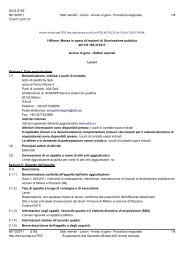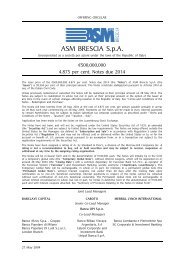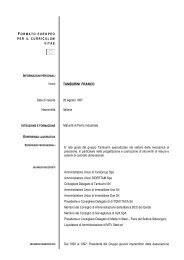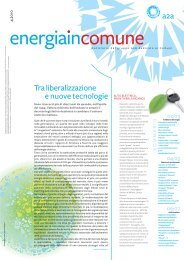Half-yearly financial Report at June 30, 2013 - A2A
Half-yearly financial Report at June 30, 2013 - A2A
Half-yearly financial Report at June 30, 2013 - A2A
- No tags were found...
You also want an ePaper? Increase the reach of your titles
YUMPU automatically turns print PDFs into web optimized ePapers that Google loves.
<strong>Half</strong>-<strong>yearly</strong> <strong>financial</strong> report <strong>at</strong> <strong>June</strong> <strong>30</strong>, <strong>2013</strong>Energy market trendsfelt especially in the north. The trend in demand in the second quarter was additionallypenalized by the average temper<strong>at</strong>ures, which staying particularly low led to a delay in the useof air-conditioners, an important factor in the increase in the summer electricity load.Reduced domestic demand led to a decrease of 4.1% in the net production of electricity, whichtotaled 135,669 GWh, and a fall on the imports side, which caused a net drop with othercountries of 2.6% compared to the first six months of 2012. Net domestic production covered86.4% of demand, in line with the first half of 2012, while net imports s<strong>at</strong>isfied the remaining13.6%.192The decrease in net domestic production was characterized by a sharp fall in thermoelectricproduction (-16.3% compared to the first half of 2012); a decisive fall in the load factor of gasand coal plants can be noted from working hours in the half year. The increased neg<strong>at</strong>ive effectwas borne by combined cycle plants, compared to an increase in the proportion of renewablesources being used for the energy requirement, which rose from 11.5% to 14.2%, and ofhydroelectric production, which increased by almost 38% over the first half of 2012 due to theabundant rainfall during the period. The rise in production from wind farms continued, withgrowth of over <strong>30</strong>% being achieved, a result obtained due to favorable we<strong>at</strong>her conditions andthe increase in installed power, as did th<strong>at</strong> from photovoltaic sources (+15% over the first halfof 2012).The weakness on the demand side for electricity in the first six months of the year hadconsiderable effects on IPEX prices. The average quot<strong>at</strong>ion of the PUN (Single N<strong>at</strong>ionwidePrice) Base Load for the period between January and <strong>June</strong> <strong>2013</strong> reached an average level of60.6 €/MWh, representing a decrease of 21.8% over the figure for the same period of theprevious year (77.5 €/MWh). The price of electricity fell both in peak hours (-23% for the PUNin the F1 band and for the PUN Peak Load) and in off-peak hours (-20% for the PUN in the F2band), which made it difficult for oper<strong>at</strong>ors to recover their variable costs also in theevening/night-time hours (photovoltaic plants with disp<strong>at</strong>ch priority remain switched off dueto the lower level of solar radi<strong>at</strong>ion).The above changes therefore affected the performance of the spark spread which wasconsiderably lower in the half year in question compared to the same period in 2012.
















